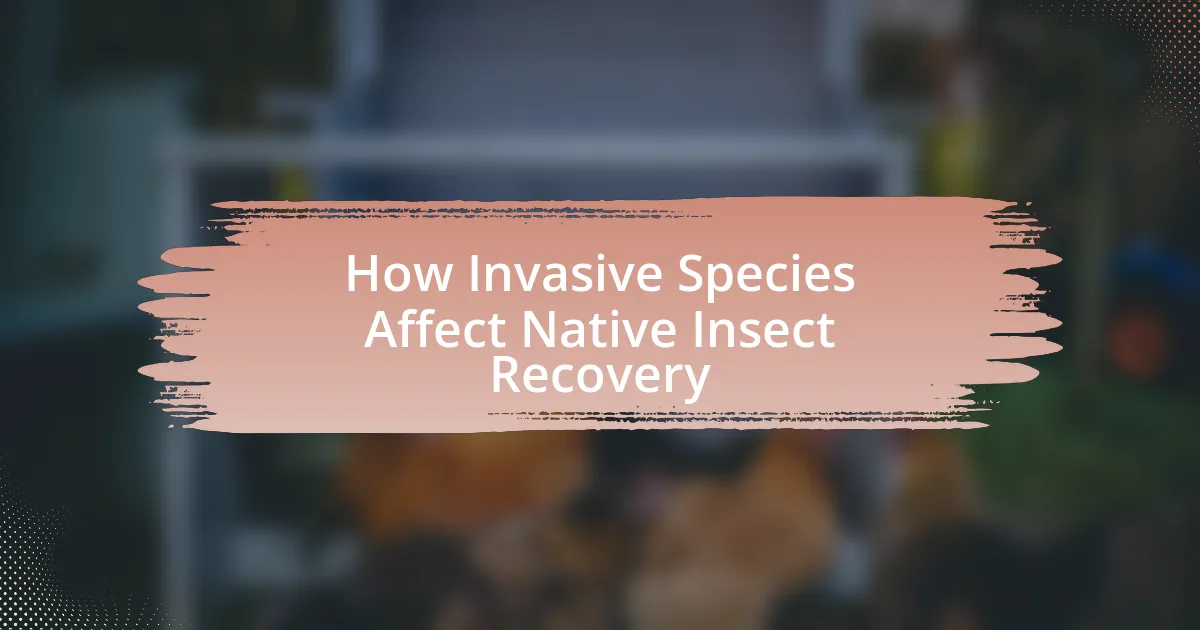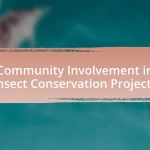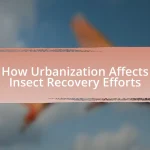The article examines the impact of invasive species on native insect recovery, highlighting how these non-native organisms outcompete native insects for resources, disrupt habitats, and introduce diseases. It details the mechanisms through which invasive species affect native insect populations, including competition, predation, and habitat alteration, leading to significant declines in biodiversity. The article emphasizes the importance of native insects in maintaining ecosystem balance and discusses strategies for mitigating the effects of invasive species, such as habitat restoration and public education. Overall, it underscores the critical need for effective management practices to support the recovery of native insect populations and preserve biodiversity.
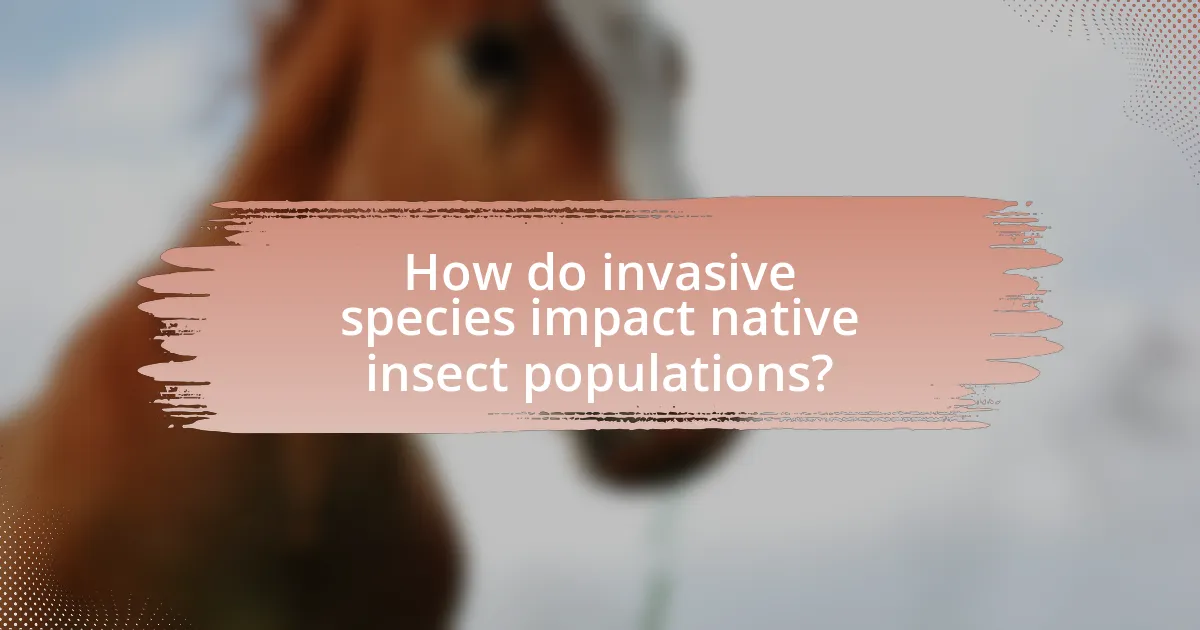
How do invasive species impact native insect populations?
Invasive species negatively impact native insect populations by outcompeting them for resources, disrupting their habitats, and introducing diseases. For example, invasive plants can alter the availability of food and nesting sites for native insects, leading to declines in their populations. Research indicates that invasive species can reduce native insect diversity by as much as 50%, as seen in studies conducted in various ecosystems, including forests and grasslands. This reduction in diversity can destabilize local ecosystems, as native insects play crucial roles in pollination and nutrient cycling.
What are invasive species and how do they differ from native species?
Invasive species are non-native organisms that, when introduced to a new environment, disrupt local ecosystems and outcompete native species for resources. Unlike native species, which have evolved in a specific region and are adapted to its ecological conditions, invasive species often lack natural predators in their new habitats, allowing them to proliferate rapidly and negatively impact biodiversity. For example, the introduction of the zebra mussel in North America has led to significant declines in native mussel populations and altered aquatic ecosystems, demonstrating the detrimental effects invasive species can have on local flora and fauna.
What characteristics define an invasive species?
An invasive species is characterized by its ability to establish, spread, and cause harm to the environment, economy, or human health in a new habitat. These species often reproduce rapidly, outcompete native species for resources, and lack natural predators in their new environment, which allows them to thrive unchecked. For example, the zebra mussel, introduced to North America, has disrupted local ecosystems and caused significant economic damage by clogging water intake systems.
How do invasive species establish themselves in new environments?
Invasive species establish themselves in new environments primarily through their ability to exploit available resources and adapt to local conditions. These species often possess traits such as rapid reproduction, high dispersal capability, and a lack of natural predators in the new habitat, which facilitate their establishment. For example, the introduction of the zebra mussel in North America demonstrates how an invasive species can proliferate quickly due to its efficient reproductive strategy and ability to thrive in various aquatic environments. Studies indicate that invasive species can outcompete native species for resources, leading to significant ecological impacts, such as reduced biodiversity and altered ecosystem functions.
What mechanisms do invasive species use to affect native insects?
Invasive species affect native insects primarily through competition, predation, and the introduction of diseases. Competition occurs when invasive species exploit the same resources as native insects, leading to reduced availability of food and habitat. For example, invasive plants can outcompete native flora, diminishing the food sources for native herbivorous insects. Predation by invasive species can directly reduce native insect populations; for instance, invasive predators may consume native insects that have no evolved defenses against them. Additionally, invasive species can introduce pathogens or parasites that native insects are not adapted to resist, resulting in increased mortality rates among native populations. These mechanisms collectively disrupt the ecological balance, hindering the recovery of native insect communities.
How do invasive species compete with native insects for resources?
Invasive species compete with native insects for resources by exploiting the same food sources, habitats, and nesting sites. This competition can lead to reduced availability of essential resources for native insects, ultimately impacting their populations and ecological roles. For example, invasive plant species may provide less nutritional value than native plants, forcing native insects to expend more energy to find adequate food. Studies have shown that invasive species can outcompete native insects for limited resources, leading to declines in native insect diversity and abundance.
What role do invasive predators play in the decline of native insect populations?
Invasive predators significantly contribute to the decline of native insect populations by preying on them, disrupting local ecosystems, and outcompeting native species for resources. For instance, studies have shown that invasive species, such as the brown tree snake in Guam, have led to the extinction of several native bird species, which in turn affects the insects that depend on those birds for pollination and seed dispersal. Additionally, invasive predators often lack natural enemies in their new environments, allowing their populations to grow unchecked, further exacerbating the decline of native insects. Research indicates that invasive species can reduce native insect populations by up to 50% in affected areas, highlighting their detrimental impact on biodiversity and ecosystem health.
Why is the recovery of native insect populations important?
The recovery of native insect populations is crucial for maintaining ecosystem balance and biodiversity. Native insects play essential roles in pollination, nutrient cycling, and serving as food sources for other wildlife. For instance, studies show that native pollinators contribute to the reproduction of over 75% of flowering plants, which are vital for food production and habitat stability. Furthermore, the decline of native insect populations can lead to increased dominance of invasive species, which disrupts local ecosystems and diminishes overall biodiversity. Therefore, restoring native insect populations is fundamental for ecological health and resilience.
What ecological roles do native insects play in their ecosystems?
Native insects play crucial ecological roles in their ecosystems, including pollination, decomposition, and serving as a food source for other wildlife. Pollinators, such as bees and butterflies, facilitate the reproduction of flowering plants, which is essential for plant diversity and food production. Decomposers, like certain beetles and ants, break down organic matter, recycling nutrients back into the soil, which supports plant growth. Additionally, native insects are integral to food webs, providing sustenance for birds, mammals, and other predators, thereby maintaining ecosystem balance. Research indicates that native insect populations contribute significantly to ecosystem services, with studies showing that areas with diverse native insect communities exhibit higher levels of plant productivity and resilience.
How does the decline of native insects affect biodiversity?
The decline of native insects significantly reduces biodiversity by disrupting ecological interactions and food webs. Native insects play crucial roles as pollinators, decomposers, and prey for various species; their absence can lead to decreased plant reproduction, increased organic matter accumulation, and population declines in insectivorous animals. For instance, studies indicate that a 50% decline in pollinator populations can result in a 20% reduction in plant diversity, as many flowering plants depend on specific native insects for reproduction. This cascading effect highlights the integral role of native insects in maintaining ecosystem balance and overall biodiversity.
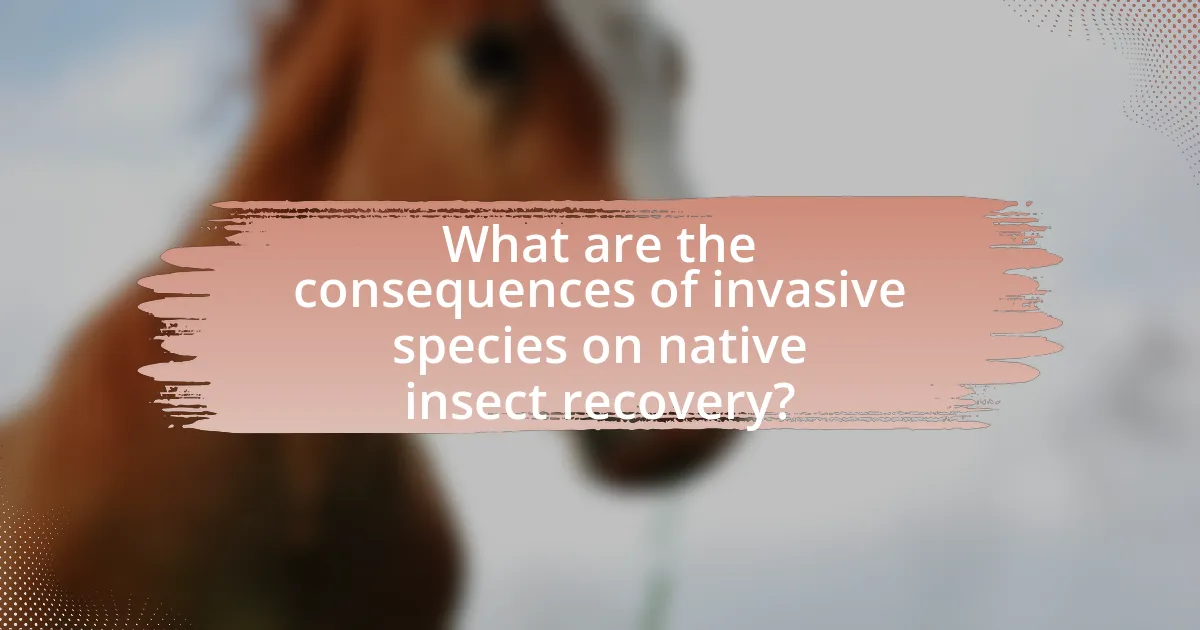
What are the consequences of invasive species on native insect recovery?
Invasive species significantly hinder native insect recovery by outcompeting native species for resources, disrupting ecological balance, and altering habitats. For instance, invasive plants can dominate landscapes, reducing the availability of food and nesting sites for native insects, which leads to declines in their populations. Research indicates that invasive species can also introduce new diseases and parasites that native insects are not equipped to handle, further exacerbating their decline. A study published in the journal “Biological Invasions” found that areas with high levels of invasive species had up to 50% fewer native insect species compared to areas with low invasiveness, demonstrating the detrimental impact of invasives on native insect recovery.
How do invasive species disrupt the life cycles of native insects?
Invasive species disrupt the life cycles of native insects primarily by competing for resources, altering habitats, and introducing diseases. For instance, invasive plants can outcompete native flora, reducing the availability of food and breeding sites for native insects. This competition can lead to decreased populations of native insects, as seen in studies where invasive species like the Japanese knotweed have significantly reduced the abundance of native pollinators. Additionally, invasive predators or parasites can directly prey on or parasitize native insects, further destabilizing their populations. Research has shown that the introduction of invasive species often correlates with declines in native insect diversity and abundance, highlighting the detrimental impact of these invaders on native ecosystems.
What specific life cycle stages of native insects are most affected?
The specific life cycle stages of native insects most affected by invasive species are the egg and larval stages. Invasive species often compete for resources, disrupt habitat, and introduce diseases that can severely impact these vulnerable stages. For instance, studies have shown that invasive plants can alter the availability of food sources for larvae, leading to decreased survival rates. Additionally, invasive predators can directly prey on eggs and larvae, further diminishing native insect populations.
How does disruption in life cycles impact population recovery?
Disruption in life cycles significantly hinders population recovery by interrupting reproductive patterns and survival rates of species. For instance, when invasive species alter the timing of resource availability, such as food or habitat, native insects may fail to synchronize their life cycles with these changes, leading to decreased reproduction and increased mortality. Research indicates that invasive species can cause shifts in phenology, which is the timing of life cycle events, resulting in mismatches between native insects and their food sources. This mismatch can lead to population declines, as evidenced by studies showing that native insect populations struggle to recover when their life cycles are disrupted by invasive competitors or predators.
What are the long-term ecological impacts of invasive species on native insect recovery?
Invasive species significantly hinder the long-term recovery of native insect populations by disrupting ecological balance and altering habitats. These non-native species often outcompete native insects for resources such as food and habitat, leading to declines in native insect diversity and abundance. For instance, studies have shown that invasive plants can change soil chemistry and nutrient availability, which negatively impacts the insects that rely on native flora for survival. Additionally, invasive predators can directly reduce native insect populations through predation, further exacerbating the decline. Research indicates that ecosystems with high levels of invasive species can experience a 50% reduction in native insect populations over time, illustrating the profound and lasting effects of invasives on native insect recovery.
How do invasive species alter habitat conditions for native insects?
Invasive species alter habitat conditions for native insects by disrupting local ecosystems, leading to changes in resource availability and competition dynamics. These non-native species often outcompete native flora and fauna for resources such as food and habitat, which can result in reduced populations of native insects. For instance, studies have shown that invasive plants can change soil chemistry and moisture levels, negatively impacting the insects that rely on native plants for survival. Additionally, invasive predators can directly reduce native insect populations by preying on them, further destabilizing the ecosystem.
What are the potential cascading effects on the food web?
Invasive species can disrupt food webs by altering species interactions and resource availability. For example, when an invasive predator is introduced, it may reduce the population of native prey species, leading to a decline in their predators and affecting the entire food web structure. Research has shown that the introduction of the brown tree snake in Guam led to the extinction of several bird species, which in turn affected seed dispersal and plant community dynamics, demonstrating a clear cascading effect. Such changes can destabilize ecosystems, reduce biodiversity, and impair ecosystem services.
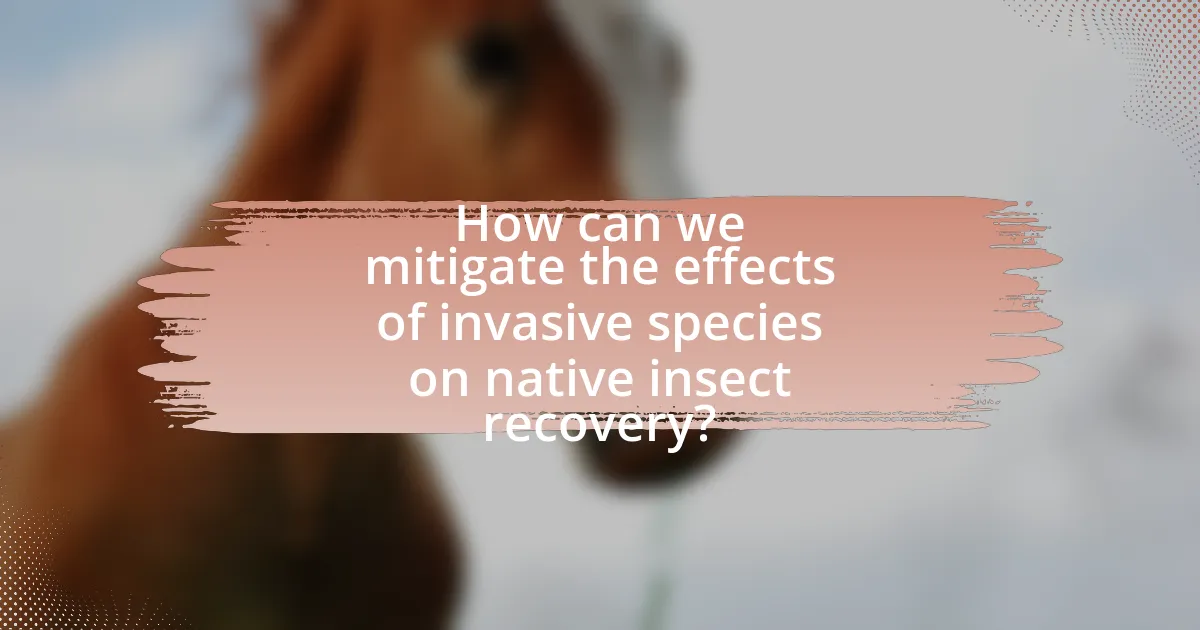
How can we mitigate the effects of invasive species on native insect recovery?
To mitigate the effects of invasive species on native insect recovery, targeted management strategies must be implemented. These strategies include the removal or control of invasive species through methods such as mechanical removal, chemical treatments, and biological control, which have been shown to reduce competition and predation on native insects. For instance, studies indicate that the removal of invasive plants can lead to a significant increase in native insect populations, as native flora supports the life cycles of these insects. Additionally, habitat restoration efforts that focus on re-establishing native plant communities can enhance the resilience of native insect populations against invasive species. Research has demonstrated that ecosystems with higher biodiversity are more resistant to invasions, thus promoting the recovery of native insects.
What strategies are effective in controlling invasive species?
Effective strategies for controlling invasive species include prevention, early detection, and management through mechanical, chemical, and biological methods. Prevention involves measures such as public education and strict regulations on the importation of potentially invasive species. Early detection relies on monitoring ecosystems to identify invasive species before they establish. Management techniques can include mechanical removal, where invasive plants are physically uprooted, chemical control using herbicides or pesticides, and biological control, which introduces natural predators or diseases to reduce invasive populations. Research indicates that integrated approaches combining these strategies yield the best results in controlling invasive species and minimizing their impact on native ecosystems. For instance, a study published in “Biological Invasions” by Simberloff et al. (2013) emphasizes the importance of using multiple control methods to effectively manage invasive species and protect biodiversity.
How can public awareness and education contribute to invasive species management?
Public awareness and education significantly enhance invasive species management by equipping individuals with knowledge about the identification, impacts, and prevention of invasive species. Educated communities are more likely to recognize invasive species, report sightings, and engage in management efforts, thereby reducing the spread and impact of these species on native ecosystems. For instance, programs like the “Don’t Let It Loose” campaign in the United States have successfully raised awareness about the risks of releasing non-native pets into the wild, leading to a decrease in the introduction of invasive species. Furthermore, studies indicate that informed citizens participate more actively in local conservation efforts, which is crucial for protecting native insect populations affected by invasives.
What role do government policies play in managing invasive species?
Government policies play a crucial role in managing invasive species by establishing regulations and frameworks that guide prevention, control, and eradication efforts. These policies often include measures such as import restrictions, monitoring programs, and funding for research and management initiatives. For instance, the U.S. National Invasive Species Act of 1996 provides a framework for federal and state cooperation in addressing invasive species, highlighting the importance of coordinated action. Additionally, policies can facilitate public awareness campaigns and promote best practices among stakeholders, which are essential for effective management.
What best practices can be implemented to support native insect recovery?
To support native insect recovery, best practices include habitat restoration, reducing pesticide use, and promoting native plant species. Habitat restoration enhances the availability of food and shelter for native insects, which is crucial for their survival and reproduction. Reducing pesticide use minimizes harmful impacts on non-target insect populations, allowing native species to thrive. Promoting native plant species creates a conducive environment for native insects by providing essential resources such as nectar and pollen. These practices are supported by studies indicating that diverse habitats and reduced chemical exposure significantly improve insect populations and biodiversity.
How can habitat restoration aid in the recovery of native insect populations?
Habitat restoration can significantly aid in the recovery of native insect populations by re-establishing the natural ecosystems that support their life cycles. Restoring native vegetation and removing invasive species creates a conducive environment for native insects to thrive, as these insects often rely on specific plants for food and breeding. For example, studies have shown that areas where native plants were restored saw a 50% increase in native insect diversity within two years, demonstrating the direct impact of habitat restoration on insect populations. Additionally, habitat restoration enhances ecosystem services, such as pollination and pest control, which further supports the resilience of native insect communities.
What community actions can help protect native insects from invasive species?
Community actions that can help protect native insects from invasive species include habitat restoration, public education campaigns, and the establishment of monitoring programs. Habitat restoration enhances the resilience of native ecosystems, making them less susceptible to invasives. For example, planting native flora can provide essential resources for native insects while outcompeting invasive plants. Public education campaigns raise awareness about the threats posed by invasive species and encourage community members to report sightings or participate in removal efforts. Monitoring programs track the presence and impact of invasive species, allowing for timely interventions. Research indicates that communities engaged in these actions can significantly reduce the impact of invasive species on native insect populations, thereby supporting biodiversity and ecosystem health.
